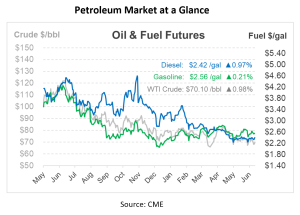
What is it – Low Carbon Fuel Standard (LCFS)
The California Low Carbon Fuel Standard (LCFS) is a term that’s likely surfaced in conversations amongst transportation fuel producers, retail gas station owners, and fleet operators. Yet, due to its intricate nature, understanding this complex program may be challenging. Today’s What Is It article aims to unravel the mysteries of the LCFS and explore its inception, functioning, and benefits, especially focusing on the petroleum industry.
What is the Low Carbon Fuel Standard?
The Low Carbon Fuel Standard (LCFS) is a regulation in the state of California that aims to reduce the carbon intensity of transportation fuels. It’s based on a lifecycle analysis of the greenhouse gas emissions associated with a particular fuel, from production through to combustion.
The LCFS was first implemented in California and subsequently adopted by other regions of the United States. The goal of the standard is to decrease the carbon intensity of the transportation sector, which is one of the largest contributors to greenhouse gas emissions. Under the LCFS, transportation fuel suppliers (producers and importers) must demonstrate that the carbon intensity of their fuel meets a declining annual standard. They can achieve this through a mix of strategies:
- Blending lower carbon fuels into their fuel mix.
- Producing their own low-carbon fuels.
- Purchasing credits from other suppliers who exceed the standard.
Biofuels, electricity, hydrogen, and natural gas are all examples of lower-carbon fuels that can be used to meet the standard. The LCFS is intended to stimulate innovation in the transportation sector and promotes the use of cleaner, more sustainable fuels.
California also has a cap-and-trade style carbon system, which tends to get confused with the LCFS but is a separate policy incurring its own, separate fees on high carbon fuels.
Introduction to the LCFS Program
Introduced in 2011 by the California Air Resources Board (CARB), the LCFS is a market-based initiative primarily intended to cut the carbon intensity of fuels used across California. It’s one among several measures under Assembly Bill 32 (AB32) designed to curtail greenhouse gas emissions throughout the state by 20% by 2030 and 80% by 2050.
The LCFS program offers multiple opportunities for credit generation, thereby encouraging the production and utilization of low-carbon fuels and facilitating the attainment of AB32 objectives. There are three primary ways to generate credits under the LFCS program:
Fuel pathway-based crediting: This method allows low-carbon fuels in California’s fuel pool to generate credits based on emissions reduction compared to the established carbon intensity baseline, incentivizing producers and importers to introduce more clean fuel options in the state.
Project-based crediting: Projects aimed at reducing emissions across the petroleum supply chain and those involving carbon capture and sequestration (CCS) using direct air capture fall under this category.
Zero-emissions vehicle infrastructure (capacity-based) crediting: Credits can be generated through the installation of hydrogen and DC fast-charging electric infrastructure based on capacity.
How the LCFS Program Works
The LCFS program works through credits. Let’s say a gallon of diesel emits 100 gCO2e/MJ (grams of CO2 equivalent per megajoule), and California requires a carbon intensity of 80 for fuels in a particular year. Fuel distributors or obligated parties who exceed their emissions targets must buy credits (passing along the higher cost) to make up the difference between what diesel emits and the standard set by California. This often includes big emissions producers like refiners or parties that ship fuel from the refinery to the terminals and then sell the fuel over the rack. Conversely, if renewable diesel has a carbon intensity of 30, it will generate credits because it’s below the standard.
The Importance of the LCFS Program
California has long grappled with air quality issues, with transportation-related emissions as a major contributor. The LCFS tackles these issues by setting immediate and long-term environmental targets for air quality improvements. LCFS is increasingly reducing transportation-related emissions and enhancing air quality in regions most affected. According to the California Air Resources Board (CARB), which oversees the LCFS, the standard has resulted in a significant decrease in the carbon intensity of California’s transportation fuels. CARB reported that, from the program’s implementation in 2011 through 2019, the carbon intensity of the state’s transportation fuels had declined by more than 7%. This reduction translates to a cumulative decrease of 38.4 million metric tons of carbon dioxide equivalent emissions, which is equivalent to taking 8 million cars off the road for a year.
The LCFS program’s credit values have sparked interest in clean fuel development, including new technology and the use of new renewable feedstocks. Increased production of clean fuel leads to a more abundant supply, instilling the necessary confidence for fleet operators to contemplate transitioning from petroleum diesel. The value of the LCFS credit is retained by the producer of the renewable fuel, whether it’s being produced in California or imported into the state. The party eligible to receive the credit decides how much to share, and this is reflected in the cost of renewable fuel in the state of California being at parity, or in the case of biodiesel blends, less than the cost of petroleum-based diesel fuel. The fleet operator gets the benefit of lower emissions and regulatory compliance at a slightly lower cost structure.
Other Regions with an LCFS Program
Although California is the frontrunner in terms of the LCFS implementation and evolution, states such as Oregon and Washington have also implemented similar programs. On the international front, Brazil and Canada have finalized a clean fuel standard in the past year, which will begin a transition to cleaner burning fuels.
In the US, the idea of a federal LCFS gained momentum this past February with a hearing to discuss the enactment of a national-level policy. Nothing came of the hearing, and experts predict that the program will continue to be driven at the state and local levels.

This article is part of Daily Market News & Insights
MARKET CONDITION REPORT - DISCLAIMER
The information contained herein is derived from sources believed to be reliable; however, this information is not guaranteed as to its accuracy or completeness. Furthermore, no responsibility is assumed for use of this material and no express or implied warranties or guarantees are made. This material and any view or comment expressed herein are provided for informational purposes only and should not be construed in any way as an inducement or recommendation to buy or sell products, commodity futures or options contracts.





